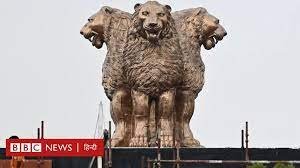20 Jul 2022 National symbol

National symbol – Today Current Affairs
- The Prime Minister of India recently unveiled the 6.5 meter high National Emblem on top of the new Parliament House under construction.
Today Current Affairs
National Symbol of India:
- The State Emblem of India is the national emblem of the Republic of India and is used by the central government, several state governments and other government agencies.
History : The Hindu Analysis
- The emblem of India (National Emblem) is a replica of the Lion Pillar of Ashoka at Sarnath.
- Basically it has four lions which are standing facing all the four directions. Below it is a round base on which an elephant, a horse, a bull and a lion are made in a running posture. This circular base is in the form of a blooming inverted lotus.
- It is carved out of monolithic stone and the Dhamma Chakra is adorned on its top.
Adopted symbol:
- In the emblem of the nation it was adopted by the Government of India on 26 January 1950, in which only three lions are visible and the fourth is hidden which is not visible.
Salient Features of the National Emblem of India : The Hindu Analysis
- The State Emblem of India is the official seal of the Government of India.
- Four animals are depicted representing the four directions:
A running horse: in the west
- Horse Kanthak represents the horse, which is said to have been used by the Buddha to leave his princely life.
An Elephant: In the East
- The elephant depicts the dream of Queen Maya, where a white elephant enters her womb.
A bull: in the south
- Ox represents the zodiac sign of Taurus, the month in which Mercury was born.
A lion: in the north
- Leo represents the attainment of knowledge.
- It seems that the animals follow each other, spinning the wheel of existence for eternity.
- The word Satyameva Jayate from Mundaka Upanishad, which means ‘Truth Alone Triumphs’, is inscribed under the top panel in Devanagari script.
- The four lions are symbols of the Buddha spreading Dharma in all directions.
- It was built in memory of the first sermon by Buddha which is known as Dharmachakrapravartana.
- As per these rules, the National Emblem of India can be used only in accordance with the provisions of the State Emblem of India (Prohibition of Improper Use) Act, 2005 and any unauthorized use is punishable under the law.
- Violation of the law can be punished with imprisonment of up to 2 years or a fine of up to Rs 2000.
Use : The Hindu Analysis
- On the letterhead of the Central Government, State Government and other government agencies.
- On the currency of India.
- On Indian passport.
- The Ashoka Chakra in the national flag is taken from the national emblem.
On buildings : The Hindu Analysis
- President’s House
- Parliament House
- Supreme Court
- High Court
- Central Secretariat
- Secretariat Buildings of States and Union Territories
- Raj Bhavan/Raj Niwas
- State Legislature
- Complex of India’s diplomatic missions abroad
- Residence of Heads of Missions in countries they recognize
- At the entrance to the buildings of Indian Consulates abroad
Mauryan Pillar : The Hindu Analysis
- Maurya pillars are rock cut pillars thus displaying the skill of the carver.
- Stone pillars erected by Ashoka have been found in the north Indian part of the Maurya Empire with inscriptions on them.
- Large figures of bull, lion, elephant etc. have been carved on the top part of the pillar.
- All sizable figures are erected and carved on a square or circular abacus.
- The abacus is decorated in lotus style.
Some examples of Mauryan pillars : The Hindu Analysis
- Lauria Nandangarh Pillar (West Champaran, Bihar)
- Ashoka Pillar (Sanchi, Madhya Pradesh)
- Lion Pillar of Ashoka, (Sarnath, Varanasi, Uttar Pradesh)
Some other national symbols of India:
National flag : The Hindu Analysis
- The National Flag of India is a horizontal tricolor with saffron at the top, white in the middle and green at the bottom in equal proportions. The ratio of the width of the flag to its length is two to three. In the center of the white stripe is a dark blue wheel that represents the circle.
- The design of the national flag was adopted by the Constituent Assembly of India on July 22, 1947.
National Anthem : The Hindu Analysis
- Jana-gana-mana, the national anthem of India, originally composed in Bengali by Rabindranath Tagore, was adopted in its Hindi version by the Constituent Assembly as the national anthem of India on January 24, 1950.
- It was first sung on December 27, 1911 at the Kolkata session of the Indian National Congress.
National Song : The Hindu Analysis
- Vande Mataram song in Sanskrit by Bankim Chandra Chatterjee.
- On January 24, 1950, President Dr. Rajendra Prasad said in the Constituent Assembly that “Vande Mataram song, which has played a historic role in the struggle for Indian independence, will be honored equally with Jana Gana Mana and will get equal status with it.
National animal : The Hindu Analysis
- Tiger, Panthera tigris is a striped animal. It has dark yellow stripes.
National flower : The Hindu Analysis
- Lotus (Nelumbo nucifera garten) is the national flower of India.


No Comments